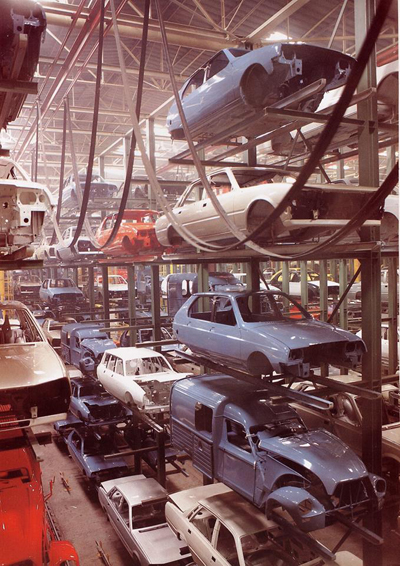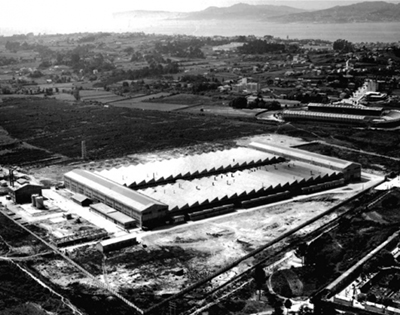Fabricados en España
(Made in Spain)
|
|
|
|
|
Key dates
1924: creation in Madrid of SEAC (Sociedad Española de Automobiles
Citroën), which had as its objective the import and sales of vehicles
of the mark in Spain (from 1919, private entrepreneurs had imported
vehicles that they bought in France).
1958: creation of the company Citroën Hispania and the launch of the
factory in Vigo which initially produced utility vehicles derived from
the 2CV. In 1977, this company absorbed SEAC and created the subsidiary
Citroën Hispania S.A.
2001: creation of Automóviles Citroën España in 2001, as a result of a
reorganisation of the Group.
2012: the core services of the brand in Spain were integrated into the
structure of PSA Peugeot Citroën Ibérica.
|
 |
In April 1958 Citroën, responding to the
high tariff barriers that protected Spain's domestic auto-makers,
established the Vigo car plant in Galicia. As in many countries,
imported cars were taxed at a higher rate than domestically produced
vehicles and this led many manufacturers to build cars in strategically
important markets. Local regulations usually required that a
certain percentage (by value) of a car must use domestically produced
parts and components and labour. Vigo was the chosen location because
it was both a port and a free port. Transactions that occur
within a free port are generally not subject to local taxes which
facilitates the export of products.
Citroën Hispania started trading in April 1958 in some old customs
warehouses but then moved to its current location in Balaídos in August
1959.
The initial workforce was around 100 workers.
The 2CV AZU van was the first car to be produced by Citroën Hispania in
Vigo. The first 25 vehicles took a month to manufacture and were
exported to Morocco.
Production totalled 400 vehicles in the first year of operation.
The 2CV berline was added to the product range in late 1959.
In 1960, production reached 3,600 vehicles and the workforce exceeded
500. Three years later, total production of the AZU, 2CV and H
van exceeded 19,000 vehicles.
The second half of the 60s and the first half of the 70s was not a good
time for the company despite introducing new models such as the Dyane 6
and Méhari. The majority of production was for the domestic
market where demand had fallen and this coincided with the arrival in
Spain of new manufacturers.
|
Left
- the Dynam
was a Spanish built and Spanish market version of the Ami 6 Break
|
|
The oil crisis in 1973 had special impact on the automotive
industry.
In Spain, rising unemployment and inflation together with social
conflicts following Franco's death should have created more problems
but paradoxically, the factory achieved its best ever results. The
introduction of the Spanish-built Citroën GS was the major factor. By
1975, 110,000 units had been produced and the workforce increased
to more than 6,000.
In 1975 Peugeot acquired 90% of the capital of Citroën and created the
PSA Group. From this time on the Group's plants produced models from
both brands.
In 1977 the first Peugeot vehicle (504) was manufactured at Vigo and
inn the 1980s, the Peugeot 505 was added followed by the Peugeot
Partner where it was built alongside the Berlingo in the 1990s.
The 1980s were characterised by the modernization of the plant and
introduction of fully robotised welding.
Alongside the Peugeot 505 the CX and the commercially succesful Citroën
Visa,
Citroën BX, and Citroën AX were built. The success of the C15 van
(with more than one million being produced) was a turning point in
Vigo's industrial activity and it participated in the design and
subsequent evolution of this model.
Spain joined the EEC in 1986 and as a result import tarifs on goods
imported from other EEC countries were abolished. This opened up
the Spanish domestic market to foreign manufacturers.
In addition to commercial vehicles, the factory built Citroën ZX
(517,484 units between 1991 and 1997) and Citroën Xsara (247,705 units
between 1997 and 2000).
During the first decade of the new millennium, factory production
doubled helped by the introduction of the Berlingo and Partner, and the
Citroën Xsara Picasso which was introduced in 1999 and represented
another success for the Vigo plant. The Xsara Picasso was
produced only in Vigo. Subsequent models such as the C4 Picasso and C4
Grand Picasso have built on this success.
|
 |
Above
picture of the Vigo production line
|
|
Citroën also has a factory in Madrid which in 1978 was
incorporated into the industrial structure of PSA Peugeot Citroën.
|
|
Dates
|
Model
|
Number built
|
|
1958 - 1970
|
AZU
|
106,005
|
|
1959 - 1984
|
2CV
|
280,459
|
|
1962 - 1965
|
Type H
|
426
|
|
1964 - 1964
|
2CV Sahara
|
85
|
|
1967 - 1978
|
AK
|
196,037
|
|
1967 - 1977
|
3CV, Dynam and 8
|
101,132
|
|
1968 - 1983
|
Dyane 6
|
233,104
|
|
1969 - 1980
|
Méhari
|
12,429
|
|
1971 - 1986
|
GS and GSA
|
418,128
|
|
1976 - 1980
|
CX
|
17,199
|
|
1977 - 1987
|
AYU
|
249,321
|
|
1981 - 1988
|
Visa
|
231,905
|
|
1983 - 1992
|
BX
|
222,325
|
|
1984 - 2005
|
C15
|
1,181,407
|
|
1986 - 1997
|
AX
|
812,951
|
|
1991 - 1997
|
ZX
|
517,484
|
|
1996 - 2008
|
Berlingo
|
1,521,021
|
|
1997 - 2000
|
Xsara
|
247,705
|
|
1999 - 2010
|
Xsara Picasso
|
1,531,816
|
|
 |
Above - aerial view of the Vigo plant
|
|
Total Spanish production was more than 11,600,000 as at
2010 of which more than 84% were exported.
More than 60% of Citroëns sold in Spain are built there.
Citroën's five best-selling models are built in Spain.
|
|
Current production includes:
- C4 Cactus (in Madrid)
- C4 Picasso and C4 Grand Picasso
- C-Elysée
- Berlingo
Cars built in Madrid include:
- LNA (1983 to 1985) 4,267 units
- Xsara (1998-2005): 359,242 units
- C3 (2002-2010: 368,626 units
- C3 Pluriel (2002-2010): 115,129 units
|
|
|
|
|
|
|
© 2017 Citroënët |




